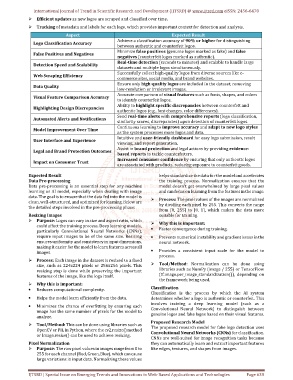Page 648 - Emerging Trends and Innovations in Web-Based Applications and Technologies
P. 648
International Journal of Trend in Scientific Research and Development (IJTSRD) @ www.ijtsrd.com eISSN: 2456-6470
Efficient updates as new logos are scraped and classified over time.
Tracking of metadata and labels for each logo, which provides important context for detection and analysis.
Aspect Expected Result
Achieve a classification accuracy of 90% or higher for distinguishing
Logo Classification Accuracy
between authentic and counterfeit logos.
Minimize false positives (genuine logos marked as fake) and false
False Positives and Negatives
negatives (counterfeit logos marked as authentic).
Real-time detection (seconds to minutes) and scalable to handle large
Detection Speed and Scalability
datasets and multiple logos simultaneously.
Successfully collect high-quality logos from diverse sources like e-
Web Scraping Efficiency
commerce sites, social media, and brand websites.
Ensure only high-quality logos are included in the dataset, removing
Data Quality
low-resolution or irrelevant images.
Accurate comparison of visual features such as fonts, shapes, and colors
Visual Feature Comparison Accuracy
to identify counterfeit logos.
Ability to highlight specific discrepancies between counterfeit and
Highlighting Design Discrepancies
authentic logos (e.g., font changes, color differences).
Send real-time alerts with comprehensive reports (logo classification,
Automated Alerts and Notifications
similarity scores, discrepancies) upon detection of counterfeit logos.
Continuous learning to improve accuracy and adapt to new logo styles
Model Improvement Over Time
as the system processes more logos and data.
Intuitive and user-friendly dashboard for easy logo submission, result
User Interface and Experience
viewing, and report generation.
Assist in brand protection and legal actions by providing evidence-
Legal and Brand Protection Outcomes
based reports to tackle counterfeiters.
Increased consumer confidence by ensuring that only authentic logos
Impact on Consumer Trust
are associated with products, reducing exposure to counterfeit goods.
Expected Result helps standardize the data for the model and accelerates
Data Pre-processing the training process. Normalization ensures that the
Data pre-processing is an essential step for any machine model doesn't get overwhelmed by large pixel values
learning or AI model, especially when dealing with image and can focus on learning from the features in the image.
data. The goal is to ensure that the data fed into the model is
clean, well-structured, and optimized for learning. Below are Process: The pixel values of the images are normalized
by dividing each pixel by 255. This converts the range
the detailed steps involved in the pre-processing phase:
from [0, 255] to [0, 1], which makes the data more
Resizing Images suitable for training.
Purpose: Logos can vary in size and aspect ratio, which Why this is important:
could affect the training process. Deep learning models, ·
particularly Convolutional Neural Networks (CNNs), Faster convergence during training.
require input images to be of the same size. Resizing · Prevents numerical instability and gradient issues in the
ensures uniformity and consistency in input dimensions, neural network.
making it easier for the model to learn features across all ·
images. Provides a consistent input scale for the model to
process.
Process: Each image in the dataset is resized to a fixed
size, such as 224x224 pixels or 256x256 pixels. This Tool/Method: Normalization can be done using
libraries such as NumPy (image / 255) or TensorFlow
resizing step is done while preserving the important
(tf.image.per_image_standardization()), depending on
features of the image, like the logo itself.
the framework being used.
Why this is important:
· Reduces computational complexity. Classification
Classification is the process by which the AI system
· Helps the model learn efficiently from the data. determines whether a logo is authentic or counterfeit. This
· Minimizes the chance of overfitting by ensuring each involves training a deep learning model (such as a
image has the same number of pixels for the model to Convolutional Neural Network) to distinguish between
genuine logos and fake logos based on their visual features.
analyze.
Proposed Research Model
Tool/Method: This can be done using libraries such as The proposed research model for fake logo detection uses
OpenCV or PIL in Python, where the cv2.resize() method Convolutional Neural Networks (CNNs) for classification.
or Image.resize() can be used to achieve resizing.
CNNs are well-suited for image recognition tasks because
Pixel Normalization they can automatically learn and extract important features
Purpose: The raw pixel values in images range from 0 to like edges, textures, and shapes from images.
255 for each channel (Red, Green, Blue), which can cause
large variations in input data. Normalizing these values
IJTSRD | Special Issue on Emerging Trends and Innovations in Web-Based Applications and Technologies Page 638

